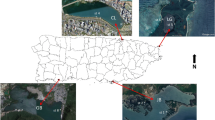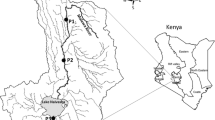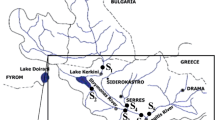Abstract
Passive sampling could provide the solution to problems associated with costly and time consuming sampling programmes and biomonitoring. Mussels (Mytilus edulis) and Chemcatcher passive sampler were simultaneously analyzed for sequestered pesticides and polychlorinated biphenyls (PCBs) by gas chromatography with mass spectrometry (GC/MSD). The Chemcatcher passive sampler based on a solid phase extraction disc with two types of diffusion-limiting membranes (polyethelene and polysulphone), were also compared. Diuron, atrazine, irgarol and lindane were accumulated in the polysulphone passive sampler in greater concentration than in the mussels or in the other passive samplers with polyethelene limiting-membrane. Mussels can accumulate in their tissue high concentration of non polar compounds such as PCB 52, dieldren and PCB 153; more than the passive sampler with polysulphone membrane. The device with polyethelene limiting membrane has high affinity capacity to concentrate high amount of phenenthrene, dieldrin, PCB 153 and PCB 52, so it acts as a sampler for non-polar compounds. The highest uptake rate of hydrophobic compounds by Chemcatcher was observed for analytes with log octanol-water partition coefficient (KOW) between 4.5 and 7.5. Laboratory-based studies using passive samplers to assess the potential for bioaccumulation could provide robust and reliable information at relatively low cost compared to biomonitoring data. Laboratory data obtained using passive samplers could be related to accumulation under field conditions where field assessments are required.
Similar content being viewed by others
References
Alvarez DA, Petty JD, Huckins JN, Jones-Lepp TL, Getting DT, Goddard JP, Manahan SE (2004) Development of a passive, in situ, integrative sampler for hydrophilic organic contaminants in aquatic environments. Environ Toxicol Chem 23:1640–1648
Bergqvist P-A, Strandberg B, Ekelund R, Rappe C, Granmo A (1998) Temporal monitoring of organochlorine compounds in seawater by semipermeable membranes following a flooding episode in Western Europe. Environ Sci Technol 32:3887–3892
Burmaster DE, Menzie CA, Freshman JS, Burris JA, Maxwell NI, Drew SR (1991) Assessment of methods for estimating aquatic hazards at superfund-type sites: a cautionary tale. Environ Toxicol Chem 10:827–842
Ellis GE, Huckins JN, Rostad CE, Schmitt CJ, Petty JD, MacCarthy P (1995) Evaluation of lipid-containing semipermeable membrane devices for monitoring organochlorine contaminants in the upper Mississippi River. Environ Toxicol Chem 14:1875–1884
El-Shenawy NS, Greenwood R, Abdel-Nabi IM (2007) Histological responses of marine mussel; Mytilus edulis to long-term exposure to sublethal-level of lindane and atrazine. Acta Zool Sinica 53(5):899–909
Greenwood R, Mills GA, Roig B (2007) Introduction to emerging tools and their use in water monitoring. Trends in Analy Chem 26(4):263–267
Greenwood R, Mills GA, Vrana B (2009) Review: Potential applications of passive sampling for monitoring non-polar industrial pollutants in the aqueous environment in support of REACH. J Chromatog A 1216:631–639
Herve S, Paukku R, Paasivirta J, Heinonen P, Sodergren A (1991) Uptake of organochlorines from lake water by hexane-filled dialysis membranes and by mussels. Chemosphere 22:997–1001
Hofelt C, Shea D (1997) Accumulation of organochlorine pesticides and PCBs by semipermeable membrane devices and Mytilus edulis in New Bedford Harbor. Environ Sci Technol 31:154–159
Huckins JN, Tubergen MW, Manuweera GK (1990) Semipermeable membrane devices containing model lipid: a new approach to monitoring the bioavailability of lipophilic contaminants and estimating their bioconcentration potential. Chemosphere 20:533–552
Huckins JN, Manuweera GK, Petty JD, Mackay D, Lebo JA (1993) Lipid-containing semipermeable membrane devices for monitoring organic contaminants in water. Environ Sci Technol 27:2489–2496
Johnson GD (1991) Hexane-filled dialysis bags for monitoring organic contaminants in water. Environ Sci Technol 255:1897–1903
Kingston JK, Greenwood R, Mills GA, Morrison GM, Persson BL (2000) Development of novel passive sampling system for the timeaveraged measurement of a range of organic pollutants in aquatic environments. J Environ Monitor 2:487–495
Koester CJ, Simonich SL, Esser BK (2003) Environmental analysis. Analytical Chemistry 75:2813–2829
Lebo JA, Gale RW, Petty JD, Tillitt DE, Huckins JN, Meadows J, Orazio CE, Echols KR, Schroeder DJ (1995) Use of the semipermeable membrane device as an in situ sampler of waterborne bioavailable PCDD and PCDF residues at subpartsper-quadrillion concentrations. Environ Sci Technol 29: 2886–2892
Lebo JA, Zajicek JL, Huckins JN, Petty JD and Peterman PH (1992) Use of semipermeable membrane devices for in situ monitoring of polycyclic aromatic hydrocarbons in aquatic environments. Chemosphere 25:697–718
Litten S, Mead B, Hassett J (1993) Application of passive samplers (PISCES) to locating a source of PCBs on the Black River, New York. Environ Toxicol Chem 12:639–647
Namiesnik J, Zabiega B, Kot-Wasik A, Partyka M, Wasik A (2005) Passive sampling and/or extraction techniques in environmental analysis: a review. Analyt Bioanaly Chem 381:279–301.
Peterson SM, Apte SC, Batley GE, Coade C (1995) Passive sampling for chlorinated pesticides in estuarine waters. Chem Spec Bioavail 7:83–88
Petty JD, Huckins JN, Martin DB, Adornato TG (1995) Use of semipermeable membrane devices (SPMDS) to determine bioavailable organochlorine pesticide residues in streams receiving irrigation drainwater. Chemosphere 30:1891–1903
Sabaliunas D and Sodergren, A (1997) Use of semi-permeable membrane devices to monitor pollutants in water and assess their effects: a laboratory test and field verification. Environ Pollut 96:195–205
Sodergren A (1987) Solvent-filled dialysismembranes simulate uptake of pollutants by aquatic organisms. Environ Sci Technol 21:855–859
Stuer-Lauridsen F (2005) Review of passive accumulation devices for monitoring organic micropollutants in the aquatic environment. Environ Poll 136:503–524
Verhaar HJM, Busser FJM, Hermens JLM (1995) Surrogate parameter for the baseline toxicity content of contaminated water: simulating the bioconcentration of mixtures of pollutants and counting molecules. Environ Sci Technol 29:726–734
Vrana B, Mills GA, Allan IJ, Dominiak E, Svensson K, Knutsson J, Morrison G, Greenwood R, (2005a) Passive sampling techniques for monitoring of pollutants in water. Trends Analyt Chem 24:845–868
Vrana, B., Mills, G.A., Dominiak E., Greenwood R. (2006) Calibration of the Chemcatcher passive sampler for the monitoring of priority organic pollutants in water. Environ Pollu 142:333–343.
Vrana B, Mills G, Greenwood R, Knutsson J, Svensson K, Morrison G (2005b) Performance optimization of a passive sampler for monitoring hydrophobic organic pollutants in water. J Environ Monitor 7:612–620
Vrana B, Popp P, Paschke A, Schuurmann G (2001) Membrane-enclosed sorptive coating. An integrative passive sampler for monitoring organic contaminants in water. Analy Chem 73: 5191–5200
Author information
Authors and Affiliations
Corresponding author
Rights and permissions
About this article
Cite this article
El-Shenawy, N.S., Greenwood, R., Abdel-Nabi, I.M. et al. Comparing the passive sampler and biomonitoring of organic pollutants in water: A laboratory study. Ocean Sci. J. 44, 69–77 (2009). https://doi.org/10.1007/s12601-009-0008-1
Received:
Revised:
Accepted:
Published:
Issue Date:
DOI: https://doi.org/10.1007/s12601-009-0008-1




